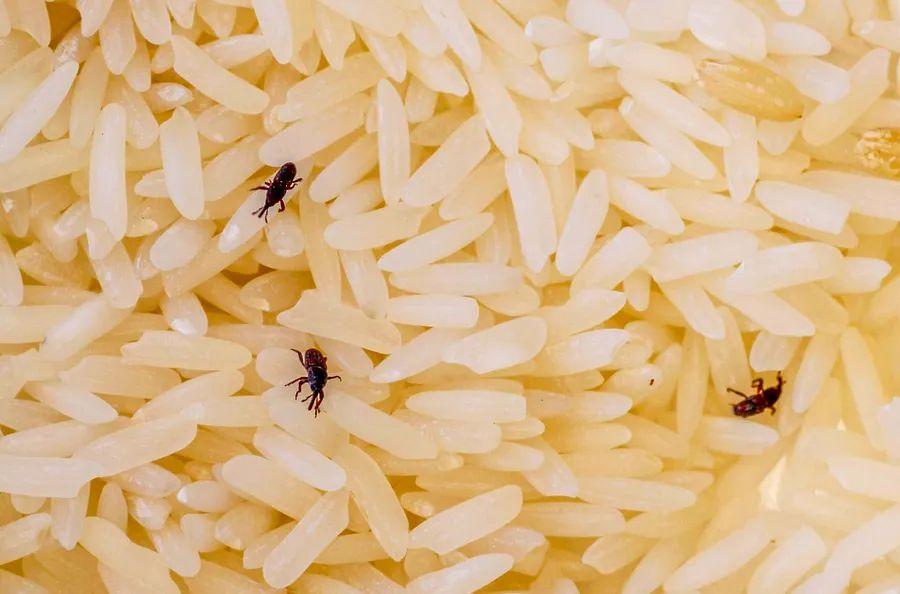Why Are There Bugs in My Dry Food and How Do I Get Rid of Them?

You followed the pandemic advice, filling your pantry for the long term. Maybe you’re a member of a warehouse club, have a large family, or you simply love those BOGO deals. Either way, you stocked up on flour for baking, pasta or rice that seemingly never expire, and bulk quantities of cereals, pancake mixes, oatmeal, and instant potatoes.
Now, you’re spotting tiny black or brown bugs, 8 to 10 millimeters long, with bent snouts crawling through your dry goods. In the corners of your pantry, you find piles of them—some dead, some still moving. They’re even in sealed boxes of mac and cheese. Who are these pests? How did they invade your pantry? And most importantly, how do you eliminate them?
Introducing the Weevil
Meet the rice and maize weevils, just two of the over 60,000 types of plant-eating beetles. These pests are a nightmare for any pantry. According to entomologists at Ehrlich Pest Control, rice weevils in particular are known to infest a variety of foods, including rye, barley, buckwheat, table beans, cotton, grapes, cashews, cereals, pasta, birdseed, and wheat products.
Dave Lofquist, Technical Training Manager at Arrow Exterminators, explains that adult weevils can live for months and can travel quite a distance from the original infested item. Their powerful chewing mouthparts can break through plastic and cardboard packaging, allowing them to spread the infestation.
In other words, weevils are top-tier pests—they don’t seem picky about what they eat and can easily burrow into or escape from sealed packaging. Lofquist adds, 'Some even damage vegetable gardens and ornamental plants.'
Scott Svenheim, Director of Training Services at Truly Nolen Pest Control, adds that weevils also feed on furniture, clothing, fabrics, and decorative items. He recommends completely discarding any contaminated food, along with thoroughly cleaning and vacuuming the pantry.
How Weevils Make Their Way In
According to the experts, weevils often enter your home along with imported goods like rice, sunflower seeds, and feed corn. Lofquist points out that weevils target whole grains, and their egg, larval, and pupal stages occur within the grain itself, making them difficult to detect.
Indeed, the rice weevil is small enough to burrow into a single grain of rice, making it nearly invisible to the human eye—and certainly to the machines that sift and package large quantities of rice. Wesley Wheeler from Bug Lord confirms, 'While it may be hard to accept, weevils don’t just seek rice as a food source; they actually lay their eggs inside the rice grains. The larvae hatch, consume the grain, and eventually leave to mate, continuing the cycle.' A female weevil can lay up to 300 eggs during her life, which lasts anywhere from 32 days to six months.
Sealed bags of products that are already infested typically have poor quality control, according to Wheeler. If you purchase such an item and find it infested, it's best to discard it immediately in an outdoor trash bin.

How to Combat the Infestation
Weevils can enter your home through more than just the food supply chain. According to Lofquist, 'Rodents and other wildlife may carry seeds and nuts into your home, which could become infested with weevils or other pantry pests.' This means that the weevils you throw away could end up at your neighbor’s place if you're not careful—especially if animals like raccoons rummage through your trash.
Pest experts unanimously recommend freezing any potentially risky items, like rice or birdseed, when you bring them into your home. The method involves sealing the product in a heavy-duty plastic bag and placing it in the freezer for a few days. Jordan Foster from Fantastic Pest Control advises, 'As a rule of thumb, freeze flour, oats, cookies, cornmeal, and spices for four days after purchase.'
Experts also agree on using barrier perimeter methods to prevent weevil infestations. Wheeler suggests, 'Seal any cracks and crevices around windows and foundations, and store grains, pasta, oatmeal, cereal, and breadcrumbs in airtight containers.'
If it's too late, don't follow internet advice that tells you to simply sift through your grains, chips, crackers, and pasta, discard the visible bugs, and continue eating the products. While weevils are generally harmless, Foster warns, 'They’re like mosquitoes—while they don’t usually cause serious harm, allergic reactions or egg ingestion can lead to problems.'
Ultimately, you won’t eliminate the infestation unless you get rid of the adults, the eggs (which are hidden inside the food), and the contaminated food itself.
Here’s a piece of advice that no warehouse shopper wants to hear: 'To prevent weevils from infesting your pantry, store only small quantities of grains at a time—just enough to consume within a reasonable period,' advises Thomas Jepsen, founder of Passion Plans, an online service for architects and home builders. 'Weevils are sneaky; they can remain hidden inside grains for a while before burrowing their way out, which is why they seem to infiltrate glass containers.'
How to Keep Weevils at Bay
If you can't bear to give up bulk buying, Jepsen suggests alternative solutions that blend practical design with logical thinking. First, find and seal any 'hidden crevices' in your pantry where stray grains may have fallen. Just a single grain of rice could be enough to trigger an infestation.
Next, monitor the temperature of your kitchen. 'Though weevils might seem indestructible, they actually dislike extreme temperatures,' Jepsen notes. This is why they can be eliminated by exposing them to a relatively low oven temperature.
Lastly, assess the humidity in your home and take steps to reduce moisture levels. While weevils aren’t fond of heat, they thrive in tropical environments. 'Consider how this impacts your pest control strategy,' advises Jepsen, who regularly advises first-time homeowners.
As a reminder, Jepsen warns, 'Never, under any circumstances, use pesticides in your kitchen.'
If your weevil problem is particularly severe, simply discarding infested food and cleaning your shelves and baseboards may not be enough. 'Weevils are incredibly persistent,' say experts at Ehrlich Pest Control. 'If you're worried about a serious infestation, it’s crucial to call a pest management professional to inspect the area, ensure all weevils and eggs are removed, and create a strategy to prevent future infestations.'
Alternatively, you can try some natural remedies that may already be in your kitchen. 'Cloves and bay leaves can naturally repel weevils. Place bay leaves around your pantry and kitchen, and keep fresh cloves of garlic near your food storage areas,' suggests Foster. 'Additionally, mix one tablespoon of white vinegar with a cup of water to create a solution that will keep bugs out of your pantry and basement for up to six months.'
Evaluation :
5/5



